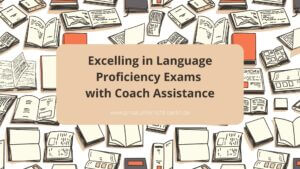Your Language Journey, Your Way: Start with a Private Tutor

Merging Web-Based Tutoring And In-Person Education For Language Learning
Learning a new language can open up a world of opportunities, from travel to career advancement. However, it can be difficult to find the time and resources for in-person language classes.
Fortunately, with technological advances, web-based tutoring has become an increasingly popular option for language learners. While online tutoring can offer convenience and flexibility, some students may need more face-to-face interaction and personalized attention.
That’s where merging web-based tutoring with in-person education comes in. By combining the best aspects of both approaches, learners can benefit from the convenience of remote learning while still receiving individualized support and feedback from experienced educators.
In this article, we’ll explore how this hybrid approach is revolutionizing language learning and helping students achieve their goals more efficiently than ever before.
Table of Contents
Benefits Of Web-Based Tutoring For Language Learning
Did you know that interactive exercises and personalized feedback are two of the most effective ways to learn a language? According to recent studies, learners who receive immediate feedback during practice sessions have better retention rates than those who do not.
This is where web-based tutoring comes in handy. One of the enormous benefits of web-based tutoring for language learning is its ability to provide learners personalized attention. Unlike traditional classroom settings, online tutoring platforms offer one-on-one instruction from qualified tutors.
Learners can work at their own pace and receive individualized feedback on areas they need improvement. Additionally, many web-based tutoring programs incorporate interactive exercises into their lessons, allowing learners to apply what they’ve learned in real-world scenarios. These features help learners stay engaged and motivated throughout their language-learning journey.
Drawbacks Of Web-Based Tutoring For Language Learning
While web-based tutoring for language learning has benefits, there are also some drawbacks.
One major disadvantage is the need for personalized feedback that students receive compared to traditional in-person education. Online tutors may be unable to pick up on specific nuances or errors that a student makes when speaking and, therefore, cannot offer targeted corrections to improve their language skills.
Furthermore, web-based tutoring needs more cultural immersion opportunities that come with in-person education. Learning a new language involves more than memorizing vocabulary words and grammar rules; it also requires understanding the culture behind the language.
In-person classes allow students to interact with native speakers and experience the language in real-life situations, helping them gain a deeper appreciation for the culture they’re studying.
Advantages Of In-Person Education For Language Learning
There’s no denying that in-person education has its advantages regarding language learning.
While web-based tutoring is convenient and accessible, something about being physically present in a classroom or with a tutor makes the experience more immersive. Immersion plays a crucial role in language acquisition – by surrounding yourself with the sounds and rhythms of a new language, you can train your ear and brain to understand it better.
Additionally, in-person education allows for greater cultural understanding. Language isn’t just about vocabulary and grammar; it’s also profoundly intertwined with culture.
When learning a new language through online resources alone, missing out on these nuances can be easy. However, having an in-person teacher or classmate who speaks the language natively can provide invaluable insights into the customs and traditions of the corresponding culture. This kind of understanding enriches your language skills and broadens your global perspective.
As we’ve seen, there are clear benefits to pursuing in-person education when studying a foreign language. But what if you could combine those advantages with the accessibility and flexibility of web-based tutoring? That’s where merging online and in-person learning comes into play – stay tuned for our next section on how this approach offers maximum results for language learners!
Combining Online And In-Person Learning For Maximum Results
The advantages of combining online and in-person learning for language learning are numerous, from access to a broader range of resources to learning more flexibly.
Strategies combining online and in-person learning should focus on effectively utilizing both formats to maximize learning opportunities.
Some common challenges of combining online and in-person learning include finding the right balance, maintaining learner engagement, and managing different platforms.
Advantages Of Combining Online And In-Person Learning
Have you ever considered the advantages of combining online and in-person learning for language acquisition? This approach to education has been gaining popularity in recent years, thanks to technology integration which makes it possible.
Combining both methods offers personalized instruction that caters to different learning styles while providing opportunities for learners to interact with other students and instructors. Online tutoring offers many resources, such as videos, interactive games and quizzes, and virtual reality environments.
Meanwhile, face-to-face interaction allows learners to practice speaking skills through role play or group discussions that foster confidence and fluency. By integrating online tools into traditional classroom settings, instructors can create a more dynamic learning environment where students have greater control over their own pace and direction of study.
Strategies For Combining Online And In-Person Learning
Now that we understand the advantages of combining online and in-person learning for language acquisition let’s explore some strategies to maximize this approach.
Collaborative activities are a great way to blend both methods seamlessly. For instance, learners can work on group projects using online tools such as Google Docs or Zoom breakout rooms while meeting in person periodically to discuss their progress and receive personalized instructor feedback.
Additionally, instructors can use blended learning models where students complete online modules at their own pace before attending physical classes for further clarification and practice.
By utilizing these strategies, educators can create a practical and engaging learning experience that caters to diverse learning styles, fosters collaboration among peers, and provides individualized attention needed for success.
Challenges Of Combining Online And In-Person Learning
As we’ve seen, combining online and in-person learning can yield significant benefits for language learners. However, this approach also presents challenges teachers must be prepared to address.
One of these challenges is teacher training; instructors need to develop new skills to effectively integrate technology into their teaching practice while maintaining a high standard of instruction.
Another challenge is student engagement; some learners may need help with the required self-motivation for effective online learning or may feel disconnected from classmates when meeting only virtually. Technological limitations and cultural differences can also create barriers to successfully implementing blended learning models.
Despite these obstacles, educators committed to creating meaningful and inclusive learning environments can overcome these challenges through careful planning, ongoing assessment, and flexibility in adapting to students’ needs.
Success Stories Of Language Learners Using Hybrid Approaches
Combining online and in-person learning has been proven to be a practical approach for language learners. In the previous section, we explored how this hybrid model can lead to maximum results. Now, let’s dive into some real-life examples of successful language learners who have used this approach.
Challenges Overcome: Success Stories of Language Learners Using Hybrid Approaches
- Maria, a Spanish learner from Brazil, improved her speaking skills by practicing with native speakers through video calls while attending weekly in-person classes.
- Ahmad, an Arabic learner from Canada, utilized online resources for grammar and vocabulary practice but credited his fluency to studying abroad and immersing himself in the culture.
- Isabelle, a French learner from the United States, found that combining self-paced online lessons with group conversation meetups helped her overcome shyness and make significant progress in her spoken French.
- Joon-Ho, a Korean learner from Australia, took advantage of virtual tutoring sessions for personalized feedback on writing assignments while participating in cultural events at his local Korean community center.
These success stories demonstrate how incorporating online and in-person experiences can help language learners achieve their goals more efficiently. Cultural immersion and language acquisition go hand-in-hand, making it essential to complement digital tools with face-to-face interactions. By taking inspiration from these examples and finding the right balance between technology-based resources and human connection, anyone can master a new language!
Frequently Asked Questions
What Specific Web-Based Tutoring Platforms Are Recommended For Language Learning?
Are you looking for a better way to learn languages? If so, web-based tutoring might be the solution you need. There are many benefits of using online platforms like Duolingo, Babbel, or Rosetta Stone to improve your language skills.
For one thing, they offer greater flexibility than traditional classroom learning, allowing you to study at your own pace and schedule. Additionally, these platforms often use interactive tools such as quizzes and games, making learning more engaging and enjoyable.
But how do you choose which platform is right for you? It depends on what kind of learner you are and what features matter most to you. Some people prefer apps that focus heavily on vocabulary building, while others want programs with lots of speaking practice opportunities.
Some popular choices include Lingoda, iTalki, and Verbling, each with unique strengths.
In summary, if you’re serious about becoming fluent in another language, it’s worth exploring the different web-based tutoring options available to find the one that suits your needs best. With so many great resources today, there’s no reason anyone can’t achieve their language goals!
Can Web-Based Tutoring Fully Replace In-Person Language Education?
Can online tutoring fully replace traditional in-person language education? This is a question that has been debated among educators and students alike.
Online language learning platforms have become increasingly popular due to their convenience and accessibility. Still, some argue that they need to fully replicate the benefits of face-to-face interaction with a teacher or peers.
While online tutoring offers flexibility and personalized instruction, it may need more social aspects and real-life practice opportunities provided by in-person classes.
Ultimately, the decision between online vs. traditional language education depends on individual preferences and goals. It’s crucial to weigh the pros and cons of each option before making a choice that best suits your needs.
How to Do Language Learners Who Are Not Tech-Savvy Fare With Web-Based Tutoring?
Challenges arise when it comes to language learners who need to be tech-savvy and use web-based tutoring.
While online learning has become a popular alternative for many, those with the necessary technological skills may need help accessing and utilizing these resources effectively.
Educational content writers must consider that some individuals may require additional guidance in navigating such platforms and provide alternative options for those who prefer face-to-face interactions.
It is essential to acknowledge that while technology can provide convenience and flexibility, it may not suit everyone’s needs or preferences.
Are There Any Cultural Or Language Barriers To Using Web-Based Tutoring For Language Learning?
Cultural misconceptions and language proficiency levels can sometimes create barriers to using web-based tutoring for language learning.
While these online resources offer convenience and flexibility, some learners may need more face-to-face interaction or feel uncomfortable navigating technology.
However, it’s important to note that these perceived obstacles are not insurmountable.
With patience, practice, and a willingness to learn, even those who may be less tech-savvy or unfamiliar with certain cultural norms can benefit from web-based tutoring in their language acquisition journey.
So don’t let fear hold you back – give it a try!
How Can Language Learners Ensure They Receive Personalized Attention And Feedback From Web-Based Tutors?
When it comes to online language learning, one of the biggest concerns for learners is how they can receive personalized attention and feedback from web-based tutors. Luckily, several tutoring techniques can help address this issue.
Firstly, selecting a tutor specializing in your target language with experience teaching online is crucial.
Next, setting clear goals with your tutor and regularly checking in on progress can ensure you receive the individualized attention you need.
Additionally, incorporating interactive activities such as role-playing exercises or conversation practice can provide opportunities for tailored feedback on specific areas of improvement.
By implementing these strategies, online language learners can feel confident that they receive quality support from web-based tutors.
Conclusion
In conclusion, merging web-based tutoring and in-person education for language learning can be a game-changer.
Several recommended platforms cater to different proficiency levels regarding language acquisition.
While web-based tutoring can only partially replace the benefits of in-person education, it offers learners the flexibility to learn at their own pace.
However, tech-savviness is only sometimes given and may pose challenges for some learners.
Cultural or language barriers may also arise, but these can be overcome with proper guidance from tutors who understand diverse backgrounds.
Personalized attention and feedback are crucial elements in any effective learning method, and this should remain a top priority even in web-based tutoring.
Combining web-based tutoring with traditional classroom settings creates an educational environment that caters to diversity while providing quality instruction tailored to each student’s needs.
By investigating the truth behind language acquisition theories, we can help our audience appreciate and enjoy the written content while gaining valuable insights into improving their language skills.



